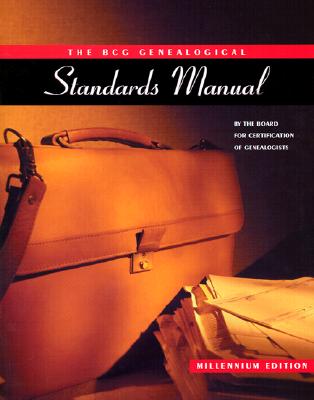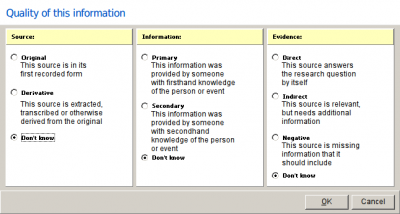Book Club Tangent: BCG Evidence Analysis

The BCG Genealogical Standards Manual
In this second post about the Second Life Genealogy Book Club discussion of Val D. Greenwood’s The Researcher’s Guide to American Genealogy (3rd Edition), I offer a tangent that lists the Board for Certification of Genealogists (BCG) version of evidence analysis to compare and contrast a few key points. Here’s the link to the post detailing Greenwood’s evidence types while the book club continues on through other chapters of that book.
| Categories | Standards |
|---|---|
| Data Collection | 1-18 |
| Evidence Evaluation | 19-34 |
| Compilation | 35-56 |
| Lecturers | 57-60 |
| Instructors | 61-66 |
| Educational Writers | 67-72 |
| Continuing Education | 73-74 |
Mentioned briefly in Greenwood’s book, in 1997, BCG discontinued the use of the “preponderance of evidence” standard and adopted a list of seventy-four standards collectively named the Genealogical Proof Standard (GPS), numbered and categorized in groups.
For this post, I’ll only quote from standards 21, 22, and 29, though others among the “Evidence-Evaluation Standards” go into further details about background context, relevance, inconsistencies, and other issues that certainly fine tune how we treat the information we find. Here I’m bringing up contrasts to the types of evidence in Greenwood’s list compared to the GPS method.
Greenwood’s list of evidence types included “direct”, “circumstantial (or indirect)”, “primary”, “secondary”, “collateral”, and “hearsay”. Four of these have matches in the GPS method, separated between pairings for sources and evidence, while the third pair I tend to include within “circumstantial” or “secondary”.
The GPS lists three main pairings — sources, information, and evidence — as distinct areas to analyze.
“21. Data analysis includes distinguishing between original and derivative sources, which are defined as
original source: the person or record whose information did not come from data already spoken or written. […]
derivative source: a person or record that supplies information that is repeated, reproduced, transcribed, abstracted, or summarized from something already spoken or written.” (BCG, 8-9)
Only the original hand-written or typeset records or recordings (audio or video) are considered original sources in this standard. All others may have various levels of derivative nature.
While most of us only have access to photographic reproductions of the original records, these do not always include every piece of information in the true original. Think of microfiche newspaper archives where corner or edge articles are distorted, cut off, or blocked by vignetting during the imaging process. When originals have been annotated with other inks or pencils, black-and-white photos or scans can make those distinctions difficult to decipher.
Another example came in a Second Life chat with Colleen Method (not her Second Life persona) from the Virtual Museum of Victorian Era Ephemera site and blog. Even the best photos do not do the pieces full justice when not only are some cards pre-printed with a faux-curled edge while others are actually curled or folded to show personal visits, but also that at least one bottle-shaped perfume sample card still retains a trace of a sample scent. Also the material texture of some distinguish them.
Further generations of derivatives are more obvious. Articles printed in the news have usually been edited for content, style, length, or unfortunate introduced errors, and can be different than the original submitted manuscript. Reprints, transcriptions, and other verbatim copies can introduce errors. And abstracts or brief notes lose information deemed not relevant to the note taker at the time.
These were mentioned within Greenwood’s “primary” and “secondary” evidence types, but are separate in GPS as evaluating sources, because both types of sources can contain both primary and secondary information. A signed signed death certificate (original source) and its database transcription (derivative source) may both contain a Doctor’s declaration of death and medical reason (primary information) and the person’s age (secondary information).
Once the source itself has been categorized, the information it contains is investigated.
“22. Data analysis includes distinguishing between primary and secondary information, which are defined as:
primary information: data contributed by a knowledgeable eyewitness to or participant in the event that is the subject of the record or by an official whose duties included making a full, accurate record of it. […]
secondary information: data supplied a person who recorded it after hearing of the event or its details from someone else.” (BCG, 9)
I think the “official duties” concession here can be problematic. Census enumerations are a classic example where Enumerators, each “an official”, recorded names phonetically because they were not privy to primary information on the names or ages. In one specific example, I have a step-2nd-great-grandfather listed with the first given name “John” for all records (including his own signatures) other than one Census enumeration that lists him as “James” with a five-year age discrepancy, and with some alternate spellings of the Germanic “Schmidt” surname over the enumerations.
In that way, “official record” may be one of the exemptions to the “hearsay” rule that Greenwood mentioned, but it does not automatically make the information “primary” or even necessarily correct. But dealing with contradictions in more detail can wait for a future post.
When the source and information are looked at in this detail, we can decide to use it as a form of evidence:
“29. Direct and indirect evidence is correlated with the question being investigated. […]
direct evidence: an evidence item that is adequate by itself to answer the question. Direct evidence answers the question at hand, but does not answer every question. […]
indirect evidence: an evidence item that is incomplete in itself and therefore inadequate to answer to the question at hand.” (BCG, 11-12)
This directly matches Greenwood’s pairing of “direct” and “circumstantial (or indirect)” evidence.
This has practical use in recent genealogical software. I’ve been using RootsMagic 4, and it references this three-way analysis directly with their options for citation quality (though they list it as information quality) — select a fact within an individual’s Edit window, click ‘Sources’ (alt-S), select a source citation, click ‘Edit’ (alt-E), then click ‘Quality’ (alt-Q):
One additional evidence option is shown, “Negative: This source is missing information that it should include”. I use this two ways:
- If the research question is “In what country or state was John Schmidt born?”, and a source that has an available line for that information was left blank, then that source is not evidence to answer that question. That it should have answered it makes it “negative”, or missing, evidence. This might be resolved by finding sources and information elsewhere.
- If the question is “What was the name of Herman Schmidt’s father?”, and all sources but one include primary or secondary information, directly or indirectly, that his name was John Schmidt, but one lists secondary information of the name as James Schmidt, then that source is “negative”, or contradictory, evidence. This may be resolved by weighing all the evidence and their varied levels of credibility.
Obligatory citation: The Board for Certification of Genealogists. The BCG Genealogical Standards Manual: Millennium Edition. New York, NY: Turner Publishing Co., 2000.





This all sounds solid, except your second example of negative evidence. This would actually be direct evidence of his name. Just because it doesn’t match what you already have in your records doesn’t mean it’s negative evidence. If the question was “What is John Schmidt’s middle name” and the source showed “James Schmidt” as his name, then it would be considered negative evidence, because you have no idea if James is his middle name or if his first name is supposed to be James.
For example, when I look at an 1880 census record for East Township, Podunk County, Montana for John Smith, and don’t find a John Smith listed, I would still cite the source, but I would list it as negative evidence. In other words, the answer to the question “Where did John Smith live in 1880?” was not there.
Your first example is spot-on, however.
That’s my take on it, anyway.
~Jenny (Erin Grantham)
I was on the fence about including that one, as it’s not an example of “missing” evidence, but one of “contradictory” (though indeed “direct”) evidence. I haven’t used that setting often in the software — though I should to help explain those missing citations in the data that my notes show I searched but didn’t find.
A better example of negative/missing evidence would be for a question about cousins of a great-grandmother, “Where were Sevren and Inga Jorgensen in 1930?”, that I used for a class about breaking down “brick walls”. The census returns for their pre-1930 and post-1930 home in San Francisco, California had no record of them for April of that year (negative evidence). Turns out that they had traveled to Europe that year before the enumerations and returned in July afterward (passenger lists under an alternate transcripted spelling I hadn’t anticipated, direct evidence).
Thanks for the comment! 🙂